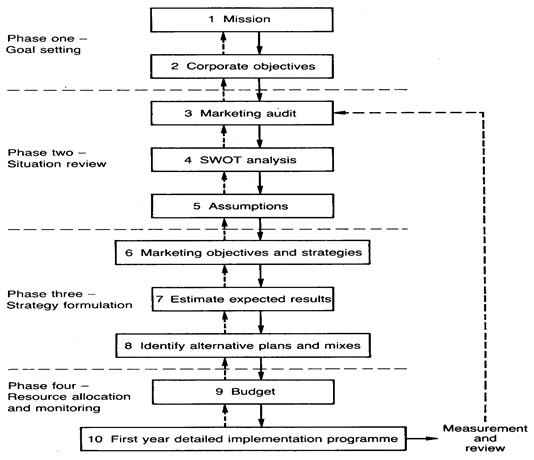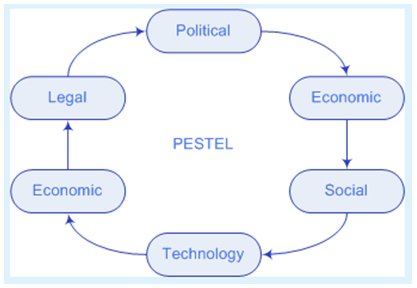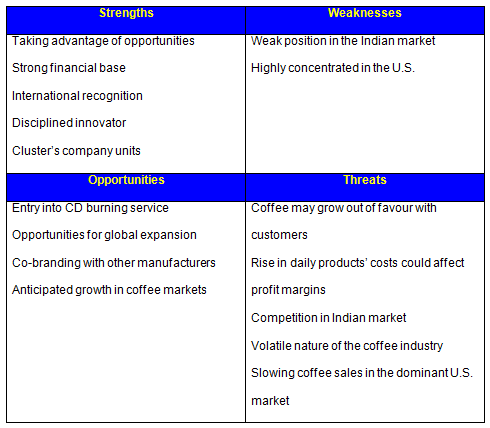Introduction
Since ages Indians have been more inclined towards tea rather than coffee. As such, marketing coffee in India can be a tough job. But owing to the marketing strategies of companies like Starbucks, a trend of coffee drinking has started picking up, especially among the younger generation.
There are certain local companies also that manufacture coffee. But the quality of such brands is not up to the mark and moreover, the target customers of such companies are the middle class customers. Middle class people include the small business people, professionals. Even the canteens in colleges and universities serve these brands of coffee. It should be understood that the market trends differ from country to country. India is a developing country and as such, the people are not accustomed to the traditions of the Western countries.
The existing managerial literature proves that the marketing strategies available for internalization are not basically the same across cultures (Cayla & Arnould, 2008). But as studies and surveys show that India is fast catching up with the Western culture, it is expected that the coffee culture will also soon be prevalent among the people.
This report analyzes and justifies a marketing plan for the introduction of instant coffee into the Indian market. The paper also outlines the possible drawbacks and the means to overcome them. The following flow chart demonstrates the graphical representation of the marketing plan.

Figure 1: Marketing Plan (McDonald & Keegan, 2002)
In this report, we shall analyse the performance of coffee in the Indian market using SWOT and PESTEL analysing methods.
Market Analysis/Audit
External Audit
This kind of audit is done on variables that the organization cannot control. One of the most commonly used tool for analysing the market of any product is PESTEL. It means the Political, Economical, Social, Technological, Environmental and Legal aspects that may affect any business.

Figure 1: PESTEL Analysis
Economic
India is currently the fifth largest economy in purchasing power parity, not mentioning its growing middle class and youth with more disposable income (Johnson & Tellis, 2008). Since the target customers are the youth, the probability of success of instant coffee in India is high.
Political
India is a huge democratic country and the government is engaged in the welfare of its citizens through various economic policies. The infrastructure system of India is becoming better day by day. These factors can be of advantage to any new company that wants to start its operations in India.
Technological
India is a fast developing country and as such, the modern technological inventions are being adopted in all spheres of life.
Social-cultural
The new company may experience uncertainty avoidance from local consumers due to the predominantly Indian tea-drinking culture. The company may also face a cultural distance between its own marketing strategies and those of its partners in joint ventures (Heerden & Barter, 2008). The enormous diversity of India, which is typified by inconsistent policies and social-economic inequalities, may also serve as a hindrance (Johnson & Tellis, 2008).
Legal
India has stringent policies regarding foreign-owned businesses. There are certain rules to be followed and taxes are imposed on foreign products.
Environmental
There are many social groups in India that are engaged in the preservation of the environment against pollution. These groups stage protests against companies that are responsible for any kind of pollution. If the new company has to face such protests, it will tarnish its image. It should be the prime concern of the company to adhere to the non-pollution policy.
Market trends: “…the market for coffee in India has been growing steadily as consumers are becoming more acceptable towards international and premium brands” (BusinessWire, 2011).
Internal Audit
This kind of audit is done on variables than can be controlled by the organization
Current Market Position
The current market position of the company will have a great impact on its venture in India. It is a human tendency or psychology to go after the renowned ones.
Target Market
Traditional target market for the new company includes the “affluent, well-educated, white collar customers” between the ages of 25 and 44. As the companies expand internationally, an emergent target market consists of the “younger, less well-educated customers in a lower income bracket” (Moon & Quelch, 2003).
SWOT Analysis

Strengths Analysis
Coffee is a habit in the Western culture. Since India is a developing country and the people are fast accepting the foreign products, the company can take advantage of the good opportunity for entering the rapidly growing instant coffee market in India.
Weaknesses Analysis
The company is yet to make inroads into the Indian tea-drinking culture and it is expected that it may meet challenges trying to establish itself (Johnson & Tellis, 2008).
The company may suffer great financial losses if the U.S. retail stores under perform because of harsh economic conditions or intense competition.
Opportunities Analysis
The company can enter into brand-franchising agreements with other partners in emerging markets to boost its sales, reputation and competitiveness (Johnson & Tellis, 2008).
Threats Analysis
- Highly competitive market
The main competitors of the company in India are Cafe Coffee Day and Barista. - Socio-political Groups
There are certain social and political groups that are opposed to foreign products. Even though the number of such groups is limited, they can create unnecessary nuisance.
Assumptions
Assumptions are critical in any marketing plan as they function to standardize the planning environment (McDonald & Keegan, 2002). This plan assumes that instant coffee will achieve a market segment of 10 percent before December 2012 as the company engages more partners and franchises in the Indian market. Price competition for the instant coffee market in India will force price levels down by 15% across the board.
Marketing Objectives & Strategies
Marketing Objectives
The marketing objective of the company should be to create a rare coffee experience that will make customers in India to visit established outlets for the coffee, stay for the striking environment, and return for the connection. It should be the policy of the company to build an image and reputation separate from competitors aimed at creating brand loyalty.
Marketing Strategies
Venkatesh notes that “…market segmentation is a strategy in which a large heterogeneous market is broken down into small homogenous segments and a separate marketing program is developed for each segment” (Venkatesh, 2011). The market segment selected for instant coffee is the high-end consumer segment and the strategy used will be price discrimination.
Estimation of Expected Results
It is expected that the introduction of instant coffee into the Indian market will assist the company to rapidly expand its retail operations and increase growth in its speciality sales and other operations. It is also expected that customers will achieve higher satisfaction levels.
Identification of Alternative Plans and Mixes
Alternative Plan
Based on initial sales of instant coffee, the company may decide to introduce a new instant coffee product to target the middle class. Sheth observes that “the new middle class, especially in large population markets in China and India, is creating large-scale first-time buyers of everything” (Sheth, 2011).
Marketing Mix for Instant Coffee
Product
The product – instant coffee – falls under the category of convenience products since it can be purchased from selected retail outlets and supermarkets. It lacks the signature bitterness and darker-roast temperament of brewed coffee, thus is seen as an excellent choice to compete in traditional tea-drinking cultures such as India (Business Pundit, n.d.).
Price
Instant coffee will be marketed to the higher-end consumer bracket, thus will be retailed at a premium price. The company wishes to use the high price tag to demonstrate the high value of the product and its commitment to adequately satisfy customer needs and demands. Chan et al are of the opinion that an effective price discrimination strategy communicates the unique value of a particular product to the customers (Chan et al, 2010).
Place
The place where a product first premiered and the distribution networks that exist to ensure the product is adequately restocked are critical success factors for any internalization exercise (Chandrasekaran & Tellis, 2008). Instant coffee is set to premier in the cities of Mumbai and New Delhi due to their affluent upper class and high population rates.
Promotion
Promotional activities are critical in exposing the product to the local audience and in targeting marketing communications with the view to elicit positive responses from the targeted audience (Narayan & Manchanda, 2009). The company’s promotional activities will revolve around the word of mouth.
Budget
Marketing and other related activities are costly and, as such, organizations intending to launch new products into global markets must prepare adequately if they are to succeed in their endeavours. The company should allocate a fixed budget for the launch and promotional activities in India.
First Year Implementation Programme
The company will embark on partnering with local enterprises that share in the values and commitments of the company. The product will be initially introduced into two of such partnerships in Mumbai and New Delhi to evaluate uptake before comprehensive roll-out strategy into other major cities across India is kicked off in 2012.
Although TV commercials will be aired in mainstream channels to introduce the new product, the main promotional strategy will be through word of mouth. A Market research survey will be done in September 2012 to assess customer attitudes and market share.
Conclusion
Studies demonstrate that most organizations target to enter international markets not only to exploit their existing competitive advantages but also to sustain and develop their strategic positioning. Other factors, such as profits and growth targets, international market opportunities, economies of scale, intense competition in traditional markets, saturated existing market and proximity to global consumers, may also account.
With the introduction of instant coffee into the mainstream Indian market, the company will not only be aiming to enhance its competitiveness but also its strategic positioning. It may take some time but if the company adheres to all the parameters mentioned in this paper, success is sure to be achieved.
References
Cayla, J. & Arnould, E.J. (2008). A Cultural Approach to Branding in the Global Marketplace. Journal of International Marketing, 16(4), 86-112.
Chandrasekaran, D. & Tellis, G.J. (2008). Global Takeoff of New Product: Culture, Wealth, or Vanishing Difference? Marketing Science, 27(5), 844-860.
Heerden, V. & Barter, C. (2008). The Role of Culture in the Determination of a Standardized or Localized Marketing Strategy. South African Journal of Business Management, 39(2), 37-44.
Johnson, J. & Tellis, G.J. (2008). Drivers of Success for Market Entry into China and India. Journal of Marketing, 72(3), 1-13.
McDonald, M. & Keegan, W.J. (2002) Marketing Plans that Work. 2nd ed. Woburn, MA: Butterworth-Heinemann.
Moon, Y. & Quelch, J. (2003). Starbucks: Delivering Customer Service. Harvard Business School.
Narayan, S. & Manchanda, P. (2009). Heterogeneous Learning and the Targeting of Marketing Communication for New Products. Marketing Science, 28(3), 424-441.
Sheth, J.N. (2011). Impact of Emerging Markets on Marketing: Rethinking Existing Perspectives and Practices. Journal of Marketing, 75(4), 166-182.